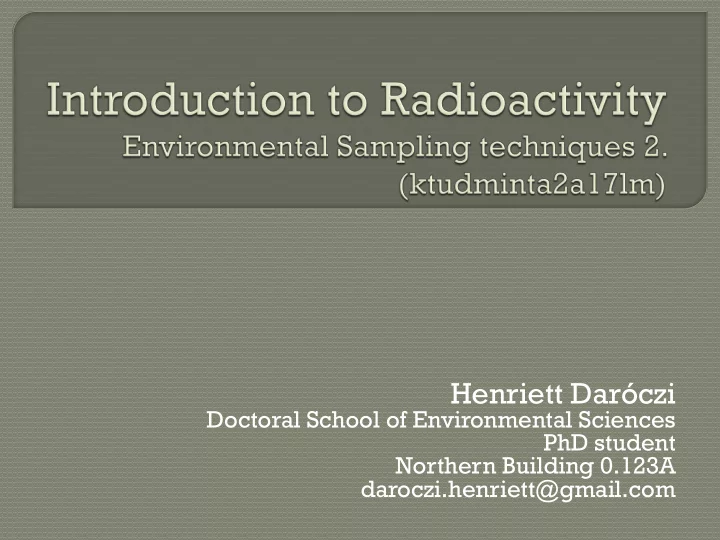

Henriett Daróczi Doctoral School of Environmental Sciences PhD student Northern Building 0.123A daroczi.henriett@gmail.com
History • 1895. Wilhelm Conrad Röntgen discovers a type of electromagnetic radiation which he calls X-rays • 1896. Henri Becquerel discovers the principle of radioactive decay when he exposes photographic plates to uranium • 1897. Sir Joseph John Thomson first describes his discovery of the electron
History • 1898. Marie and Pierre Curie announce discovery of two substances they call polonium and radium. • 1899. Ernest Rutherford classifies two types of radiation, alpha rays and beta rays. • Henri Becquerel discovers that radiation from uranium consists of charged particles and can be deflected by magnetic fields.
Marie Curie coined the term radioactivity Radiation Activity
Marie Curie coined the term radioactivity Radiation Activity • Ionizing radiation • Non-ionizing radiation
Marie Curie coined the term radioactivity Radiation Activity • Electromagnetic radiation • Particle radiation • Acoustic radiation • Gravitational radiation
Types of decays:
Types of decays: • Alpha decay • Beta decay • Gamma decay • Neutron emission • Electron capture • Proton emission • Spontaneous fission • Cluster decay • Internal conversion
Negative Beta Decay Positive Beta Decay Electron Capture
Negative Beta Decay Positive Beta Decay Electron Capture
Negative Beta Decay Positive Beta Decay Electron Capture
Negative Beta Decay Nucleus level Nucleon level Quark level
Negative Beta Decay Nucleus level Nucleon level Quark level
Negative Beta Decay Positive Beta Decay Electron Capture
Marie Curie coined the term radioactivity Radiation Activity • decay/ desintergration per second
In a simple decay, if the number of decaying nucleus is N(t)
In a simple decay, if the number of decaying nucleus is N(t) In a general case, the activity is proportional to the number of decaying atoms
In a simple decay, if the number of decaying nucleus is N(t) In a general case, the activity is proportional to the number of decaying atoms
In a simple decay, if the number of decaying nucleus is N(t) In a general the solution of case, the this differential activity is equation proportional to the number of Exponential Decay Law decaying atoms
Exponential Decay Law Decay constant λ
Exponential Decay Law Decay constant λ Half-life time T 1/2
Exponential Decay Law Decay constant λ Half-life time T 1/2
Exponential Decay Law Decay constant λ Half-life time T 1/2
Half-life time
Half-life time
Decay chain if λ 1 << λ 2 << λ 3 … << λ i
Decay chain if λ 1 << λ 2 << λ 3 … << λ i
Decay chain if λ 1 << λ 2 << λ 3 … << λ i
Decay chain if λ 1 << λ 2 << λ 3 … << λ i
Decay chain if λ 1 << λ 2 << λ 3 … << λ i Secular equilibrium
sheet of paper Al shielding very thick layer of lead light elements (hydrogen)
Stochastic vs Deterministic effects Justification Limitation ALARA Time Distance Shielding
Stochastic vs Deterministic effects Justification: no unnecessary use of radiation is permitted, which means that the advantages must outweigh the disadvantages Limitation: each individual must be protected against risks that are too great, through the application of individual radiation dose limits ALARA - "As Low As Reasonably Achievable" Time: Reducing the time of an exposure reduces the effective dose proportionally Distance: Increasing distance reduces dose due to the inverse square law Shielding: absorbing the energy of the radiation
Primordial Radionuclides Secondary Radionuclides Cosmogenic Radionuclides Artifical Radionuclides
Primordial Radionuclides are produced in stellar nucleosynthesis and supernova explosions, their half-lives are so long (>100 million years) Secondary Radionuclides derived from the decay of primordial radionuclides Cosmogenic Radionuclides are continually being formed in the atmosphere due to cosmic rays.
IAEA (2013)
IAEA (2013)
IAEA (2013)
J. Porstendörfer (1994)
Isotope sign Name First member of Mother Half-life decay series element time 222 Rn Radon 238 U 226 Ra 3.8 d 220 Rn Toron 232 Th 224 Ra 55 s 219 Rn Aktinon 235 U 223 Ra 4 s
IAEA (2013)
IAEA (2013)
Recoil ranges depending on media: • solid 20-70 nm • air ~60 m • liquid100 nm IAEA (2013)
J. Porstendörfer (1994)
J. Porstendörfer (1994)
International Atomic Energy Agency (2013): Measurement and calculation of radon releases from NORM residues. ISBN 978 – 92 – 0 – 142610 – 9 Horváth, Á. et al. (2012): Environmental Physics Methods Laboratory Pracitces Encyclopædia Britannica https://www.britannica.com/science/neptunium-series J. Porstendörfer (1994): Properties and behaviour of radon and thoron and their decay products in the air. Journal of Aerosol Science , Vol. 25, p 219-263. Khan et al., J Phys Chem Biophys 2017, 7:3 DOI: 10.4172/2161-0398.1000254 nuclear-power.net wikipedia.org
Recommend
More recommend